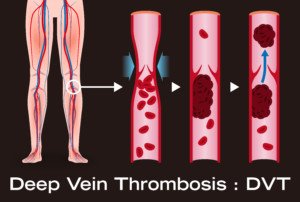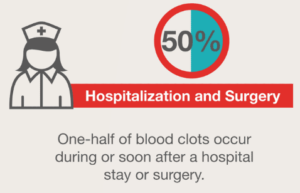
We always hear how a deep vein thrombosis (DVT) can cause pain, swelling and/or redness in the affected area, which is commonly the calf.
The blood clot may also form in the upper leg or behind the knee.
If you’ve always told yourself, “I can’t possibly have a DVT because there’s no swelling or redness,” it’s time to overhaul this way of thinking.
Can a deep vein thrombosis ever cause pain in the leg without any sign of swelling, redness or even pinkness?
“Yes, it is possible — especially early in the development of the DVT,” says Susan L. Besser, MD, with Mercy Medical Center, Baltimore; Diplomate, American Board of Obesity Medicine and board certified by the American Board of Family Medicine.
“Of course, other things can cause calf pain too (sprains and strains for example),” adds Dr. Besser.
Unexplained New Pain in the Calf or Upper Leg
• If the pain is in both calves and began about the same time, and there are no other symptoms, this is reassuring and does not point to a blood clot.
• If it’s in one leg, ask yourself what you did recently that might be bringing it on.
Did you try a step aerobics class for the first time the day before? Did you go on a hard hike or do any jumping exercises?
• Did you suffer an acute calf cramp (Charley horse) overnight? The pain can linger into the day but will not cause a blood clot.
• If the pain in your calf is activated only when you walk or climb stairs, this points to a sore muscle, but if it doesn’t go away after several days, the suspicion for DVT increasingly rises, especially if you have risk factors.
• If the new pain is there all the time and is not triggered by movement, this is suspicious for a DVT, even if there’s no swelling or redness.
• Unexplained pain behind the knee is also worrisome, as this is a very unusual location for a harmless muscle strain.
• If you’re wondering about new-onset pain in your calf, behind the knee or anywhere in the leg, ask yourself if you’ve been on a long flight recently.
Lengthy time flying with little movement of the legs can cause blood clot formation.
• Were you recently in a car for hours without stepping outside for a leg break? That’s another risk factor.

Shutterstock/metamorworks
Other Risk Factors for DVT
(no particular order)
• Recent major surgery, especially abdominal and joint replacement
• Excessive bed rest from the surgery or from a pregnancy
• Pregnancy
• Obesity or overweight
• Smoking
• Birth control pills and hormone replacement therapy
• Excessive sleep
• Genetic blood clot disorder or personal/family history of a deep vein thrombosis
• Prolonged periods of sitting throughout the day
• Older age, though young adults, even kids, can get a DVT.

If you suspect a DVT, don’t wait it out and figure “it’s nothing” just because there’s no swelling or redness.
The presence of swelling, redness or other symptoms such as excessive warmth in the leg is not predictive of how easily the clot will break off and travel to the lungs and block airflow.
The dislodgement of the clot can occur whether there is redness, swelling plus bad cramping — or only just a mild sore feeling.
When the clot reaches the lungs, it’s called a pulmonary embolism and, depending on its size and where it settles, can kill within minutes.
Dr. Besser urges people to undergo an evaluation to make sure the pain is not from a DVT.
An ultrasound will detect it. Treatment will be immediate if a blood clot is found. Pain can be caused without swelling or redness.
 Dr. Besser provides comprehensive family care, treating common and acute primary conditions like diabetes and hypertension. Her ongoing approach allows her the opportunity to provide accurate and critical diagnoses of more complex conditions and disorders.
Dr. Besser provides comprehensive family care, treating common and acute primary conditions like diabetes and hypertension. Her ongoing approach allows her the opportunity to provide accurate and critical diagnoses of more complex conditions and disorders.
 Lorra Garrick has been covering medical, fitness and cybersecurity topics for many years, having written thousands of articles for print magazines and websites, including as a ghostwriter. She’s also a former ACE-certified personal trainer.
Lorra Garrick has been covering medical, fitness and cybersecurity topics for many years, having written thousands of articles for print magazines and websites, including as a ghostwriter. She’s also a former ACE-certified personal trainer.
.


























